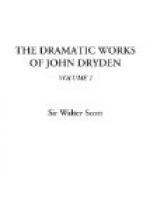[10] [This is at least not true of the “Parson’s Wedding.”—ED.]
[11] Notes on Mr. Dryden’s Poems, 1687.
[12] Preface to “King Arthur.”
[13] “I remember,” (says a correspondent of the ‘Gentleman’s Magazine,’ for 1745), “plain John Dryden, before he paid his court with success to the great, in one uniform clothing of Norwich drugget. I have eat tarts with him and Madam Reeve at the Mulberry Garden, when our author advanced to a sword and a Chadreux wig.”—Page 99 [This letter is a famous crux in the biography of Dryden. It has been suggested that the writer was Southerne, but it is impossible to make things tally. As Dryden certainly had paid his court to the great by 1670, if not by 1665, there is the almost insuperable difficulty of supposing that the writer could have associated with Dryden in parties of pleasure seventy-five years before date—a difficulty all the more difficult in that he only claims to be in his eighty-seventh year. It would be worthy of little attention, if the eager assailants of Dryden’s moral character had not sought to see evidence of the deepest turpitude in this tart-eating with Mrs. Reeve and the anonymous letter-writer.—ED.]
[14] He describes him as,
“Still smooth, as when, adorned
with youthful pride,
For thy dear sake the blushing virgins
died,
When the kind gods of wit and love combined,
And with large gifts thy yielding soul
refined.”
[15] The epilogue has these lines:
“But now if by my suit you’ll
not be won,
You know what your unkindness oft has
done,—
I’ll e’en forsake the playhouse,
and turn Nun.”
[16] [Scott’s account of the marriage is incorrect in one or two particulars, and incomplete in others. It took place on the 1st of December 1663, at St. Swithin’s, and the licence, dated the day before, removes all idea of a clandestine match or of family disapproval.
“Ultimo Novembris 1663
[Sidenote: Juratus Hen: Smyth: Jun:]
Which day appeared personally John Driden of St. Clemt. Danes in the County of Midd Esqr aged about 30ty yeeres and a Batchelor and alledged that hee intendeth to marry with Dame Elizabeth Howard of St. Martin in the Fields in the County aforesaid aged about 25 yeeres with the consent of her Father Thomas Earle of Berke not knowing nor believing any impediment to hinder the intended marriage of the truth of the prmisses he made faith and prayed Licence for them to bee married in the parish church of St. Swithins London.” [Transcriber’s note: spelling as in the original.]
While, however, this entry, discovered since Scott wrote, clears up one part of the story, another discovery has been thought to darken it again. The following letter from Lady Elizabeth Howard appears in the letters of Philip, second Earl of Chesterfield:—
“From the Lady Elizabeth Howard Daughter to the Earle of Barksshire.




